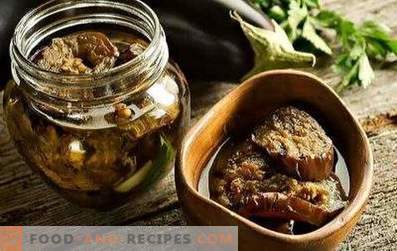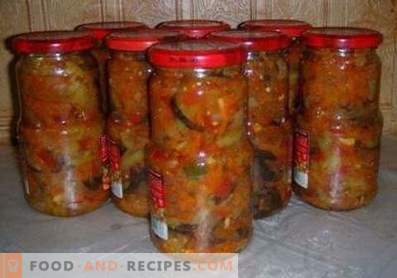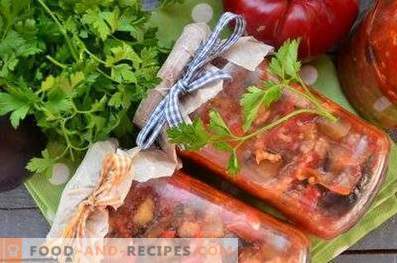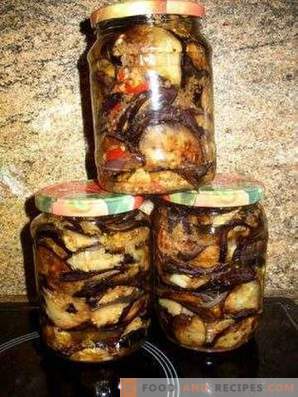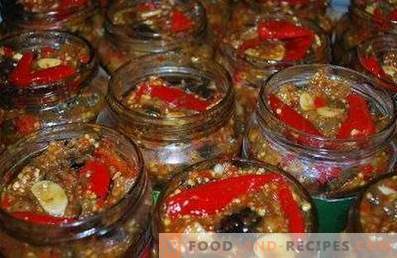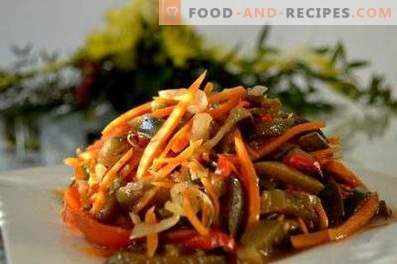
Korean pickled vegetables are popular with many for their savory taste and seductive flavor. With the spices that make up such a marinade, eggplants go well together, and they are often included in the recipes of the most popular Korean salads. Eggplant in Korean can be eaten not only in the summer-autumn season, but also in the cold season, if you have time to prepare them in advance. You can use a variety of recipes. The taste of the finished snack will depend on what kind of vegetables the “blue ones” are added to, which set of seasonings was used to prepare the marinade, and even on the way of cutting the products. It makes sense to make eggplant in Korean for the winter in several ways.
Cooking Features
Korean-style appetizers, although they have a unique taste, are easy to prepare. Even harvesting them for the winter does not cause much trouble, however, without knowing a few subtleties, you can not achieve the expected result. Knowing the nuances of technology, even an inexperienced cook will cope with the task.
- Eggplants contain solanine. This substance is considered poisonous and in large quantities can cause harm to the human body. In small doses, solanine is not too dangerous, but gives the eggplant bitterness. It is necessary to dispose of solanine, and to do it is simple: you need to salt the sliced eggplants, leave for 10 minutes, then rinse thoroughly so that they do not turn out to be salty. Another way to eliminate solanine is by soaking eggplants in a salt solution prepared from 20 g of salt and a liter of water.
- Eggplants can be marinated raw or fried. If you plan to fry eggplants, they must be thoroughly dried before. If roasting is not planned, it is enough to wait until the water completely drains from the blue ones.
- Eggplants can be sliced to make Korean-style snacks from them in cubes, circles, semi-circles, and straws. The grinding method depends on the selected recipe.
- Young eggplants with a thin skin can not be peeled, with ripe fruit peel removed necessarily, otherwise the salad will get a rough taste.
- Before being put in jars, vegetables are pickled for several hours so that they have time to put the juice. After distribution into containers, the appetizer is poured with marinade and sterilized from 30 to 60 minutes, depending on the volume of the cans. Half-liter jars with snacks sterilize half an hour, liter - an hour. It is not worth refusing sterilization in the case of eggplants, otherwise the snack will quickly deteriorate.
- Marinating vegetables is not recommended in enameled containers, since this material, when interacting with acids, forms harmful substances.
- Jars for Korean eggplant snack should be sterilized. Suitable covers should also be sterilized by boiling. Eggplant canned food should be closed with metal lids to ensure tightness, plastic for this purpose will not work.
If the preparation technology and storage conditions are observed, the eggplants in Korean will not deteriorate within a year.
Korean eggplant for winter with onions and carrots
The composition (1, 5 l):
- eggplants - 1 kg;
- carrots - 0, 3 kg;
- onions - 0, 3 kg;
- garlic - 25 g;
- hot peppers - 1 pc .;
- sugar - 80 g;
- salt - 50 g (including the cost of sprinkling eggplant to extract solanine);
- ground coriander - 5 g;
- seasoning for Korean salads - 10 g;
- Table vinegar (9%) - 50 ml.
Preparation Method:
- Wash eggplants, blot with a napkin, cut off their tips. If you have large vegetables, peel them off using a peeler.
- Cut the pulp of eggplants into long strips. Cut the eggplant strips across in half. Sprinkle with a tablespoon of salt, mix. Leave it for 10-15 minutes.
- Rinse the eggplants under running water and pat dry with a kitchen towel.
- Scrape, wash carrots. Pat dry with a napkin. Cut into strips or grate on a special grater.
- Free the bulbs from the husks, cut them into thin half rings or even quarters of the rings.
- Finely chop the garlic cloves with a knife.
- Put the chopped vegetables in a bowl or pan.
- Sprinkle with spices, salt and sugar, mix.
- Pour in vinegar, stir again.
- Leave on for 4 hours in the refrigerator, stir the snack every 30-40 minutes.
- Sterilize jars and lids.
- Spread the eggplants in a can, tamp them down with a spoon.
- Pour marinade. Cover with prepared lids.
- At the bottom of a roomy pot, lay a towel, put cans of snacks on it. Pour water into the pan, its level should reach the shoulders of the cans.
- Put the pan on a slow fire. Sterilize the jar with eggplants 30-60 minutes after the water in the pot begins to boil. Sterilization time depends on the size of the cans.
- Carefully remove the jars from the pan, roll them up.
After the eggplant has cooled, you can rearrange the snack in a pantry or other place where you usually store supplies for the winter. The salad prepared according to this recipe is well worth it at room temperature.
Korean Eggplant with Bulgarian Pepper
Composition (2 liters):
- eggplants - 1 kg;
- Bulgarian pepper - 0, 4 kg;
- carrots - 0, 4 kg;
- onions - 100 g;
- garlic - 5 cloves;
- salt - 40 g (including 20 g for processing eggplants);
- sugar - 20 g;
- black ground pepper - 5 g;
- red pepper - to taste;
- coriander - 5 g;
- turmeric - 5 g;
- table vinegar (9 percent) - 50 ml;
- vegetable oil (refined) - 80 ml.
Preparation Method:
- Eggplants, washed and dried, cut into cubes of medium size, patted, leave for 15 minutes.
- Onion, freeing from the husk, cut into thin half-rings.
- Peel carrots, rub on a special grater or cut into thin strips.
- Peppers wash, peel the seeds, removing the stem. Pepper pulp chop straws.
- Crush the garlic cloves, then chop them with a knife.
- Rinse the eggplants, leave them in a colander for a while, so that they drain the glass and dry them.
- Heat oil in a frying pan, add spices to it, heat them for 30-60 seconds to reveal the aroma.
- Mix the oil with salt, sugar, vinegar. Pour the vegetables with this marinade, mix.
- Leave the eggplants with carrots, onions and peppers to marinate for 3-4 hours.
- Fill the pre-sterilized jars with snacks, cover with lids and sterilize for 30-60 minutes in a saucepan with boiling water.
- Remove the jars from the pan, roll them up.
Special conditions for storage of a snack prepared according to this recipe are not required; it stands well at room temperature.
Korean fried eggplants for the winter
Composition (2 liters):
- eggplants - 1 kg;
- Bulgarian pepper - 0, 4 kg;
- carrots - 0, 4 kg;
- onions - 0, 3 kg;
- garlic - 4 cloves;
- hot peppers - to taste;
- salt - 40 g (without taking into account the consumption of solanine extraction);
- sugar - 20 g;
- table vinegar (9 percent) - 120 ml;
- ground coriander - 10 g;
- seasoning for Korean salads - 20 g;
- black ground pepper - 5 g;
- vegetable oil - 0, 2 liters.
Preparation Method:
- Eggplants cut into semicircles of medium thickness, dab. After 10 minutes, rinse, pat dry with a kitchen towel.
- Wash, dry the remaining vegetables.
- Peel carrots, chop with a special grater.
- Sweet pepper cut into strips.
- Cut the garlic into small pieces.
- Chop the hot pepper in the same way.
- Heat the oil in a deep frying pan, place the eggplants in it. Fry them for 5 minutes, stirring lightly over medium heat, without closing the pan with a lid.
- Place the carrots, peppers, onions and garlic in a bowl, add the eggplants along with the oil in which they were fried, mix them.
- Add salt, sugar, spices and vinegar to vegetables, mix again.
- Put the snack in the refrigerator for 2-3 hours.
- Spread the salad over the prepared jars, sterilize in a pan of boiling water.
- Hermetically close, after cooling, remove to the place of usual storage of canned vegetables.
Thanks to pre-frying, eggplants in this appetizer acquire a special taste.
Korean Eggplant is a tasty snack that many people like. More and more housewives closes her for the winter. Make it easy if you know the nuances of the culinary process.

